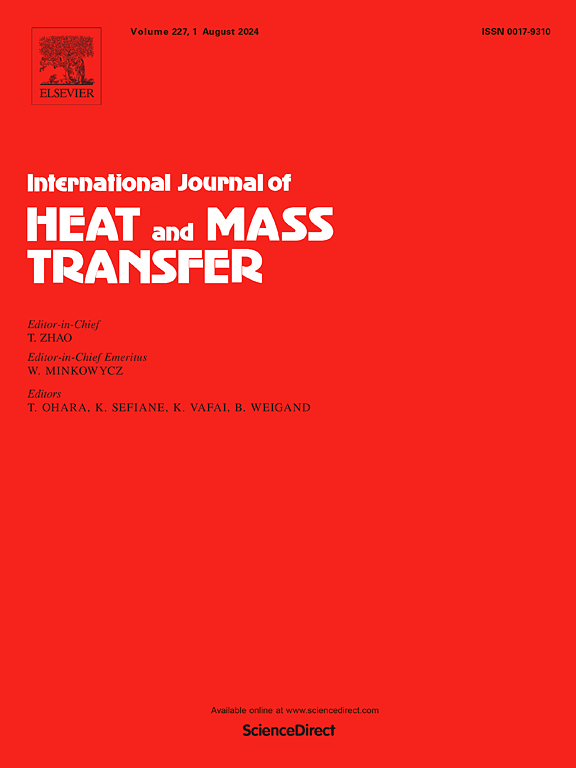Megasonic wave enhanced heat transfer in a rectangular chamber filled with HFE-7100 fluid
IF 5
2区 工程技术
Q1 ENGINEERING, MECHANICAL
International Journal of Heat and Mass Transfer
Pub Date : 2025-02-06
DOI:10.1016/j.ijheatmasstransfer.2025.126772
引用次数: 0
Abstract
This study experimentally investigated heat transfer and flow characteristics under natural convection in a closed rectangular chamber filled with HFE-7100 fluid, employing megasonic waves. Experiments using parallel heated plates with varying megasonic source distances and inter-plate spacings demonstrated a maximum heat transfer enhancement of 755 %. Particle image velocimetry (PIV) analysis revealed a megasonic wave-induced streaming effect that homogenized temperature differences within the chamber to <1 % under natural convective conditions, effectively addressing the problem of heat accumulation in localized regions. The optimal inter-plate distance between parallel heaters is critical; a reduced inter-plate distance enhances flow interactions between the heater surfaces, allowing confined streaming flow to impinge on and sweep across both boundary layers, thereby augmenting the cooling effect. In contrast, the spacing between the heaters increased, the acoustic streaming beam expanded, and its maximum velocity decreased due to the transformation of acoustic energy into beam enlargement, requiring a greater drive force to overcome acoustic energy attenuation and fluid viscosity. Additionally, the heat transfer effectiveness by megasonic waves is heat-flux dependent; strong acoustic streaming significantly reduces the thermal boundary layer at relatively low heat fluxes, resulting in more uniform temperatures. However, at higher fluxes, the waves' disruptive effect still sweeps away the thermal boundary layer with a relatively high-velocity stream, despite its thickness and vigorous natural convection, further improving heat transfer. These findings suggest that combining megasonic waves with dielectric liquids in two-phase immersion cooling systems could substantially improve thermal management in small electronic components and batteries.
求助全文
约1分钟内获得全文
求助全文
来源期刊
CiteScore
10.30
自引率
13.50%
发文量
1319
审稿时长
41 days
期刊介绍:
International Journal of Heat and Mass Transfer is the vehicle for the exchange of basic ideas in heat and mass transfer between research workers and engineers throughout the world. It focuses on both analytical and experimental research, with an emphasis on contributions which increase the basic understanding of transfer processes and their application to engineering problems.
Topics include:
-New methods of measuring and/or correlating transport-property data
-Energy engineering
-Environmental applications of heat and/or mass transfer

 求助内容:
求助内容: 应助结果提醒方式:
应助结果提醒方式:


